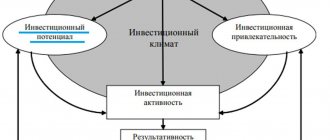Knowledge base
Opening and developing a business
* The calculations use average data for Russia
What should an ideal investment memorandum look like? I propose to look at this issue from the point of view of its attractiveness for investors and the issues that most concern them.
How to write an investment memorandum? If you ask this question to Yandex, you will get a huge number of links on how to do it “correctly”, or rather write it. The links are very different in their information content, more or less high quality and not so good.
Let's try to choose from diverse, sometimes contradictory information, the most, the most... righteous, in our opinion, but first, I suggest you imagine yourself as an investor who is made 3-5 proposals a day to invest his money in a variety of projects, from dubious to quite “attractive” (at first glance).
What do you think are the main issues that concern an investor regarding a particular investment project? In my opinion, he should be concerned with the following questions:
- How promising is this project in principle in today’s established trend in the development of business, society, technology, etc.
- How promising is the market in which it is supposed to be sold? What market share can the enterprise occupy under favorable conditions?
- How much money do you need to invest in the project?
- What will be the revenue, net profit, payback period?
- Possible risks at different stages of the project, starting from its development and ending with its work in a year, two, etc.
- Will it be possible to sell this business in 3-5 years and at what cost?
- And, in my opinion, the most basic question... If the project turns out to be “insolvent” financially, then what losses, financial losses are possible as a percentage of the invested funds? In other words, how much money will be able to be returned and over what period of time?
It seems to me that all the so-called structures of “investment memoranda” that I had to review, as well as the memorandums themselves, did not answer the last two/three questions... And these questions, as you understand, are the most basic.
The essence of the memorandum as a legal document
A memorandum is an official legal, most often diplomatic, document that sets out the essence of the issue or one party reminds the other party to fulfill a promise and/or demands that something be fulfilled. Most often, the subject of the memorandum is important state and political issues in relations between countries that cannot be resolved without the consent of both parties.
A memorandum can be interpreted in completely different meanings; the very origin of the word from the Latin “memorandum” means something that should be remembered.
The term "memorandum" includes the following meanings:
- In international relations, this is a diplomatic document of the relevant state, which sets out in detail the factual (or legal) side of some international issue, provides an analysis of certain provisions, and provides justification for the state’s position. A memorandum can also be a special diplomatic document, a memorandum outlining the government’s views on any issue; such a document is usually attached to the note, supplementing and justifying its provisions.
- Memo, official certificate.
- A letter reminding you of something (in trade), usually a debt.
- List of types of risks in insurance policies for which insurance is not provided.
- Deductibles used by the insurer and summarized for ease of use in a general table.
- A memorandum is a book that describes the history of the past.
Memorandum - most often used as an appendix to a note (a note is a document with the help of which a right or claim can be asserted, a protest against the wrong acts of another government). It sets out in detail the factual side of a particular issue, provides an analysis of any provisions or contains objections to the arguments of the other side, the memorandum-application is not written on letterhead, without a number, usually (but not in all countries) it indicates the place and date departures. If the memorandum is sent separately (the so-called express memorandum) or by courier, it is drawn up on letterhead, indicating the place and date of departure, but always without a signature or seal.
Brief historical background
When exactly in history the concept of “memorandum” was first formed, scientists do not know. But since it is of Latin origin, historians suggest that the ancient Romans and Greeks used it.
Translated from Latin, memorandum means “that which is worthy of being remembered.” Based on this, scientists concluded that the definition was originally applied differently. In simple terms, it was used to describe and record what had already happened. If an incident had the status of important, it was recorded for posterity. This was the memorandum.
Over time, the meaning has changed. And the term took the form of a kind of guide with a detailed description of the conditions for interested parties .
Examples of memorandums
An investment memorandum is a document that contains structured information that is provided to potential investors.
MoU (Memorandum of understanding) - a memorandum, a multilateral agreement between parties or companies describing a general line of action.
A debit memorandum is:
- a document used by a seller to notify a buyer that the buyer's account receivable has been debited;
- a document provided by a bank to a depositor, which informs that the depositor's bank account has been reduced due to certain events (for example, as a result of deductions for banking services).
What it is
The investment memorandum contains complete information about financial opportunities, future profits and risks. It is after analyzing this document that the investor decides whether to invest money.
Purposes of writing a memorandum
It often happens that a company needs to attract external resources. Internal reserves may be exhausted or the organization is looking for ways of large-scale development. The easiest and fastest way is to find investors.
To attract investors, it is necessary to develop a presentation document according to a logical scheme.
Differences between a business plan and a memorandum
IM can duplicate the key numbers of the business plan and focus on the same features. But there is one significant difference between these two documents.
The investment memorandum does not reflect all the intricacies of business and production processes; it does not provide a feasibility study for the production of the organization's products.
IM is intended to give a comprehensive answer from the point of view of investment attractiveness: what is the potential for future profit and risks, what is the overall prospects of the project.
Another difference: IM is a document for a narrow circle of people; it is intended only for potential investors.
Memorandum: basic concepts
As noted above, a memorandum is a legal document, the content of which may vary depending on the area in which it is used.
Memorandums are an integral part of international relations. If we consider a memorandum as a diplomatic document, then it contains a detailed justification for the position of one of the parties, usually with links to other documents, as well as analytical data; the memorandum is also an annex to a diplomatic note and is handed personally to the representative of the state with which negotiations are being conducted.
In the political sphere, a memorandum is understood as a multilateral agreement (for example, between states, public organizations or parties) in which a common line of interaction is presented or described.
As part of the paperwork and organization of activities of an organization or enterprise as a whole, a memorandum is an official letter or memorandum.
Within the framework of trade relations, a memorandum is a document that recalls some financial obligations or certain obligations within the framework of a concluded agreement.
The insurance policy, as one of the additions, may have a memorandum - a document that lists the circumstances under which insurance payments will not be made, and also reveals their essence.
Investment memoranda (as a type of legal document) contain valuable information for potential investors.
Memorandums are drawn up by lawyers during the legal assessment of documents and contracts.
That is, it can be any document that provides an explanation to a specific person or company on any legal issue.
Thus, the concept of memorandum includes a fairly wide range of legal documents that are used in various fields of activity.
Compilation rules
Creating an investment memorandum is a creative process. There is no one-size-fits-all template for all companies. As a rule, some organizations develop IM themselves, using their own experience. But here it is important not to overdo it - company analysts, for example, may inadvertently distort figures, embellish future profits and underestimate the impact of risks.
Third-party specialists and various consulting companies can help in drawing up IM; they have access to an extensive database of standards, tariffs, schemes and financial ratios. These organizations have well-developed memorandum templates and are able to combine a large amount of information and financial statistics into a document that is interesting for investors.
But attracting outside specialists has one drawback. Ignorance of the “internal kitchen” of the company, some of the key nuances characteristic of the organization, can make a future investment memorandum very inaccurate.
A well-drafted IM should be transparent, accurate, as truthful as possible, and reflect possible risks. The document must answer all the potential investor’s questions and clarify controversial issues.
Structure of the memorandum
Whatever field of activity this document is used in, it must comply with a clear structure and general requirements for such documents.
The main components of the structure of this document are:
- Introductory part (contains information about the factual side of the issue, and also outlines the essence of the document).
- The main part (indicates what the document is about, a detailed legal analysis and assessment of the problem and the tasks set in the water part).
- References to specific laws and their articles (of course, it is better not to neglect the importance and need to refer to legal norms, but at the same time, a text that is overloaded with endless names of laws and listing articles will be difficult to understand). The best option would be to mention them in footnotes, if there is a detailed answer or analysis, indicating the content of the article or its specific point. It is also better to refrain from independently interpreting articles of laws and limit yourself only to official comments.
- A warning about the consequences of solving (or not solving) the problem or task identified in the main part. This part of the document is aimed at clearly explaining the consequences of not solving the problem, as well as the options and optimal ways to solve it. Here it would be better to refrain from subjective (personal) perception of the problem and provide the optimal solution. A lawyer who is working on drawing up a memorandum must propose a mechanism for solving the problem that will be optimal for the client in the current situation.
- Conclusion (or thesis conclusions).
The memorandum can be used within a specific company or working group. Unlike a regular business letter, a memorandum is less formal and therefore shorter. Greetings and final wishes are usually absent from it. It is also worth noting that the memorandum has its own specific design.
Application in different areas
The memorandum can be used in almost any area of life where document flow is used. Most often it is compiled in the following segments:
- jurisprudence;
- business;
- international relationships;
- insurance.
In each of the listed industries, the memorandum has its own characteristics.
In jurisprudence, a document takes the form of a detailed consultation, put in written form. In its content, the memorandum resembles a legal opinion. But if the second is drawn up for the court, the first is exclusively for the client. It contains a legal assessment of the issue with full justification and references to regulations.
In business, the use of the memorandum is as wide as possible. Companies draw it up as a preliminary agreement or, as it is also called, a letter of intent. The text discusses the terms of the transaction, on the basis of which the main agreement will be concluded. Also, a memorandum can act as an offer of cooperation or be an important information letter. In cinema, namely the film industry, this term is also used. A document in this segment most often contains information about promotional and discount restrictions on film rental in cinemas . It is compiled by the film's copyright holder and addressed to distributors.
In international law, the memorandum is used on a regular basis. It is formed with the aim of explaining the state’s position on the raised problem to the second party. It may include data on types and forms of joint activities:
- creation of national programs;
- coordination of international events;
- formation of a working group.
Heads of state and heads of ministries have the right to sign the memorandum.
In the insurance business, the document is used in a narrower form - it serves to list non-insured events. This is especially true for marine policies.
Purpose of the memorandum and audience analysis
Usually the memorandum either informs about changes or invites participation in something.
The most effective memorandums connect the goals of the author with the interests of the recipients - then, as a rule, problems are resolved.
Everyone has the right to write memoranda: from junior executives to heads of companies.
Usually the memorandum is written to colleagues, but sometimes to employees of other departments or even companies involved in a common project.
When writing a memorandum, it is important to consider what information the recipients already have and what information needs to be conveyed to them.
Text construction
There are three styles of constructing a memorandum (we have already found out what this is):
- Direct - first we describe the most important thing, and only then we go into detail. Usually they write in this style about current affairs or some news.
- Reverse – context comes first, then conclusions. As a rule, they write this way about something extremely unusual, when you want to interest the recipient in something and bring him to the desired conclusion.
- Combined - this is how they announce bad news.
conclusions
Thus, a memorandum is a written document that contains important information on any issue. It is for informational and reference purposes only and is not binding. Often used in diplomatic relations between states.
Russian legislation does not provide a legal definition of the term, so many documents, both internal and external, are called memorandums. But they are united by a common goal - to focus attention on the problem.
Author of the article: Belousova Natalya
Good luck to you! See you soon on the blog pages KtoNaNovenkogo.ru
§ Marketing and sales of products:
- — market (number of possible customers, their needs, price level, possible competitors);
- — marketing strategy and achieved results;
- — existing and new products;
- — sales structure, sales personnel, methods of remuneration of sales personnel;
- — pricing, including the methodology for setting prices and their revision;
- — implementation network and possible new implementation methods;
- — methods of payment for products of main customers (possible options).











